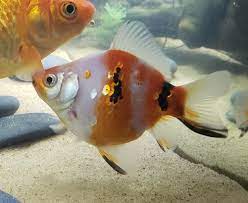All our fish, shrimp and corals are bagged with fresh oxygen as well as a heat pack in winter.
When ordering livestock please select the box size and add it to your cart for accurate overnight (1-2 days) shipping costs. A small box can take 1-2 bags and a medium box 6 bags. One bag fits max 10 small (1-3cm) fish or max 2 medium (3-5cm) fish or max 1 large (>5cm) fish.
ONE SPECIES PER BAG. Eg: One bag of 10 neon tetra.
Goldfish (Carassius auratus)
Description:
-
Appearance:
- Body: Oval and streamlined with a broad, slightly compressed body. They come in various body shapes including common, comet, and fancy types.
- Color: Typically orange or red, but can also be found in white, black, gold, and calico variations. Fancy varieties may have additional colors and patterns.
- Size: Varies greatly depending on the type. Common goldfish can grow up to 12-14 inches (30-35 cm) in length, while fancy varieties typically grow to 6-8 inches (15-20 cm).
-
Behavior:
- Activity: Active and curious; often seen swimming around the tank and interacting with their environment. They can be quite social and may recognize their owners.
- Social Structure: Generally peaceful but can be territorial or aggressive if kept in overcrowded conditions. They are best kept with other goldfish or similar-sized, non-aggressive species.
Care Requirements:
-
Tank Size:
- Minimum: 20 gallons (76 liters) for a single goldfish. For each additional goldfish, add 10-15 gallons (38-57 liters). A larger tank is preferable to accommodate their growth and waste production.
-
Water Parameters:
- Temperature: 65-75°F (18-24°C). Goldfish are cold-water fish and can tolerate a range of temperatures but prefer cooler water.
- pH: 6.0-8.0. They are adaptable to a range of pH levels but prefer slightly alkaline water.
- Hardness: Soft to hard water. They are adaptable but generally do well in moderately hard water.
- Filtration: Strong filtration is crucial as goldfish produce a significant amount of waste. Ensure the filtration system is adequate for their bioload and provides good water circulation.
-
Tank Setup:
- Substrate: Smooth gravel or sand. Avoid sharp or rough substrates that could damage their delicate fins.
- Aquascaping: Provide open swimming areas with some decorations and hiding spots. Avoid overly intricate decorations that can trap waste or impede swimming space.
- Lighting: Moderate lighting is suitable. Goldfish do well with a regular light/dark cycle to simulate natural conditions.
-
Diet:
- Primary Food: Omnivorous; feed high-quality goldfish pellets or flakes. These should be formulated specifically for goldfish to ensure they receive a balanced diet.
- Supplemental Food: Offer occasional live or frozen foods such as bloodworms, brine shrimp, and daphnia. Vegetables like blanched peas or spinach can also be provided.
-
Behavioral Considerations:
- Compatibility: Best kept with other goldfish or similarly-sized peaceful species. Avoid keeping with aggressive or very small fish that may be harassed or outcompeted for food.
- Social Behavior: Social and often enjoy the company of other goldfish. However, be cautious of potential fin nipping or competition for food.
-
Tank Maintenance:
- Water Changes: Regular water changes (25-50% weekly) are essential to maintain water quality and reduce the buildup of waste.
- Cleaning: Clean the tank regularly, including removing uneaten food and waste. Ensure the filtration system is regularly maintained and functioning properly.
-
Health Care:
- Observation: Monitor for signs of stress or illness, such as changes in behavior, loss of appetite, or visible symptoms like spots, discoloration, or fin damage.
- Treatment: Maintain optimal water conditions and consult an aquarium professional if health issues arise. Common problems include fin rot, swim bladder disorder, and fungal infections. Early detection and prompt action are crucial.

